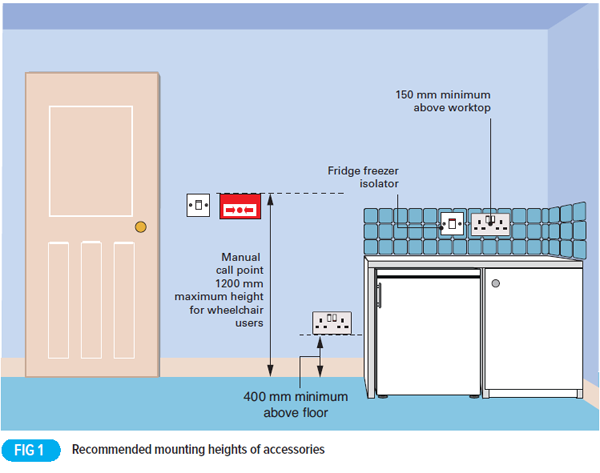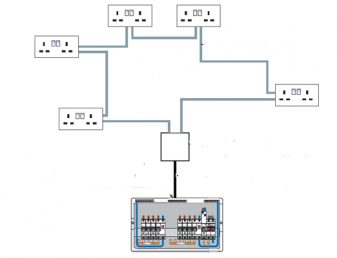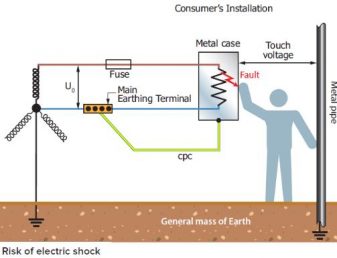The aim of this article is to explain the requirements of BS 7671, Part M of the Building Regulations for England and Wales and BS 8300: 2009 (Design of buildings and their approaches to meet the needs of disabled people) relating to the mounting heights of electrical equipment in dwellings.
In addition, the article will include recommendations on mounting heights for equipment in dwellings at risk of flooding, and on the positioning of socket-outlets adjacent to sinks.
Requirements of BS 7671
BS 7671 requires that a socket-outlet on a wall or similar structure is mounted at a sufficient height above the floor or any working surface to minimize the risk of mechanical damage to the socket-outlet or to an associated plug and flexible cord during insertion, use or withdrawal of the plug (Regulation 553.1.6 refers)
The purpose of the requirement is to avoid damage such as might result from the flexible cord being too tightly bent between the plug and the floor or working surface.
Additionally, the mounting height of wall-mounted socket-outlets and other accessories is required to be sufficient to avoid them suffering wetting or impact, such as may result from floor cleaning (Regulation Groups 522.3 and 522.6 refer).
Requirements of Part M of the Building Regulations
Part M of the Building Regulations, which applies in England and Wales, requires reasonable provision to be made for people to gain access to, and use a building and its facilities.
Section 1.18 of Approved Document M, which applies to new dwellings, includes the objective of assisting people whose reach is limited to use the dwelling more easily by locating wall-mounted switches and socket-outlets at suitable heights.
A way of satisfying the above objective, is to provide switches and socket-outlets for lighting and other accessories in habitable rooms at appropriate heights between 450 mm and 1200 mm from finished floor level (see Fig 1).
BS 8300: 2009 is a Code of Practice which includes recommendations on the mounting heights of electrical equipment to meet the needs of disabled people. The recommendations apply to the design of new buildings and for assessing the accessibility and usability of existing buildings and their improvements, although they do not apply to dwellings or residential buildings designed exclusively for use by disabled people. The upper and lower limits of mounting height given in BS 8300 are reproduced in Table 1.

Some of the heights in Table 1 fall outside the 1200 mm maximum and 450 mm minimum mounting heights referred to in Approved Document M. In such cases, it may be advisable to select mounting heights that meet the recommendations of both Table 1 and Approved Document M.
Where installing a socket-outlet at the upper height limit might create an increased trip hazard, for example to a child tripping over a flexible cord plugged into the socket-outlet, consideration should be given to mounting the socket-outlet at the lower height limit.
To enable access by wheelchair users, outlets, switches and controls should be at least 350 mm from room corners.
Dwellings liable to flooding
Guidance on issues relating to flooding is given in a publication called Prepare your property for flooding, and a free electronic copy can be downloaded by visiting the ‘Flood’ section of the Environment Agency’s website www.environment-agency.gov.uk.
Further guidance on flooding (including flood risk) is given in Approved Document C – Site preparation and resistance to contaminants and moisture, which applies to England and Wales, can be downloaded by visiting the UK government’s building regulations website www.planningportal.gov.uk.
When undertaking work at a dwelling at risk of flooding, consideration should be given to the following issues, some of which are included in Prepare your property for flooding:
- Electrical equipment such as consumer units, meters (subject to agreement with the distributor) and socket-outlets should be mounted above the expected flood level.
- Cables supplying lower floor power should be routed through an upper floor to prevent possible damage from a lower floor flood.
- Cables likely to be damaged by flooding should be drawn into plastic conduit. Drain holes are required in such conduits to prevent water collecting at the conduit low points, thereby reducing the risk of long-term water damage to cables and associated equipment. The provision of such conduits might reduce the amount of rewiring work required following a flood (depending on the amount of water and mud entering such conduits and associated equipment).
As far as equipment belonging to the electricity distributor is concerned, the Electricity Safety, Quality and Continuity Regulations (ESQCR) 2002 requires the distributor to install and, so far as is reasonably practicable, maintain the equipment to prevent danger (Regulation 24 of the ESQCR refers). In compliance with the requirements of Regulation 24 the distributor may be required to take account of flooding.
13 A BS 1363 socket-outlets and similar accessories installed adjacent to a sink, tap or wash basin
To reduce the effects of splashing, socket-outlets and similar accessories, as a rule of thumb, should be mounted at not less than 300 mm (ideally not less than 1000 mm) in the horizontal plane, from the extremities of a sink, tap or wash basin.
For other guidance and publications please see the ELECSA website. Information about the ELECSA Domestic Installers schemes, visit www.elecsa.co.uk






